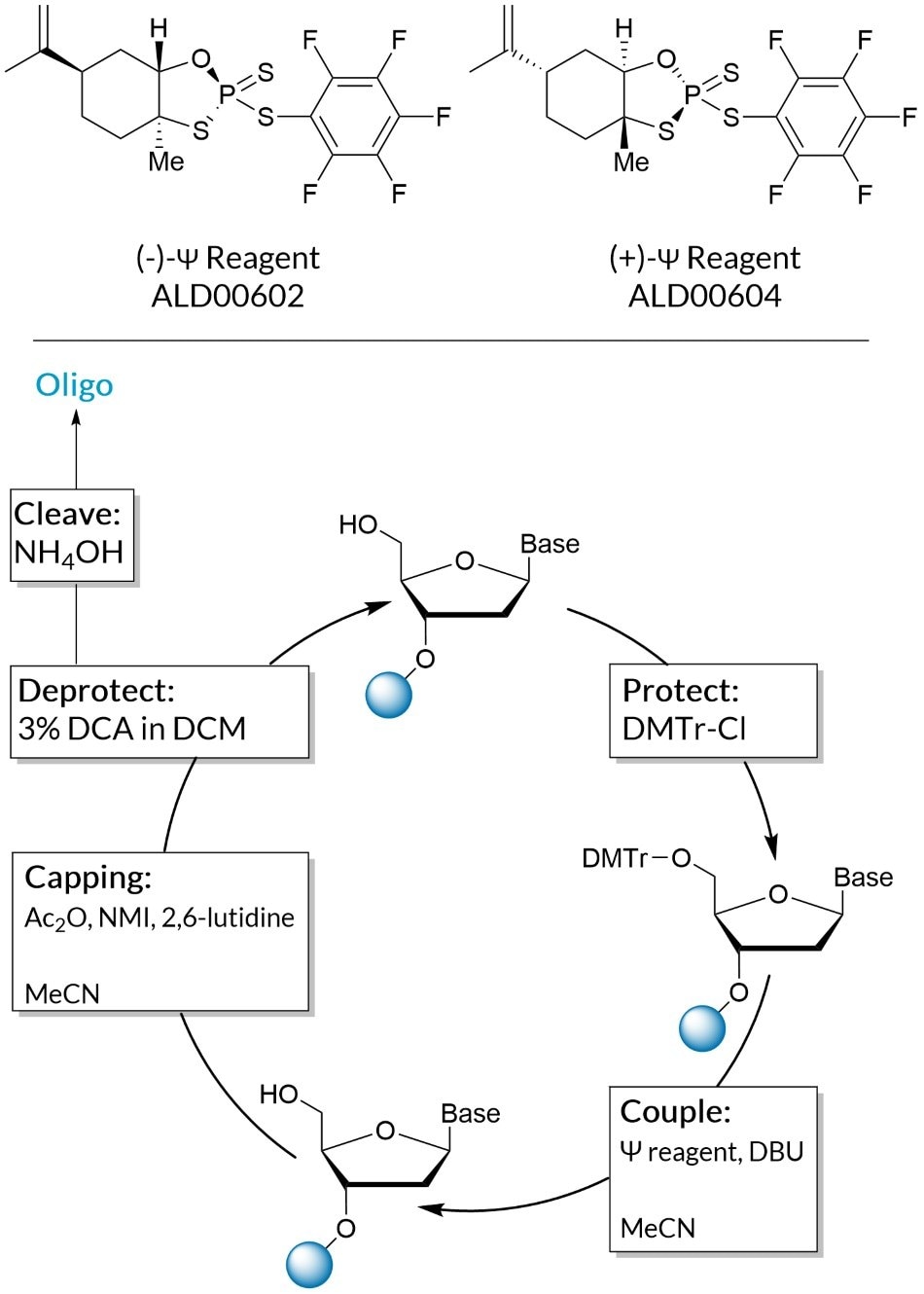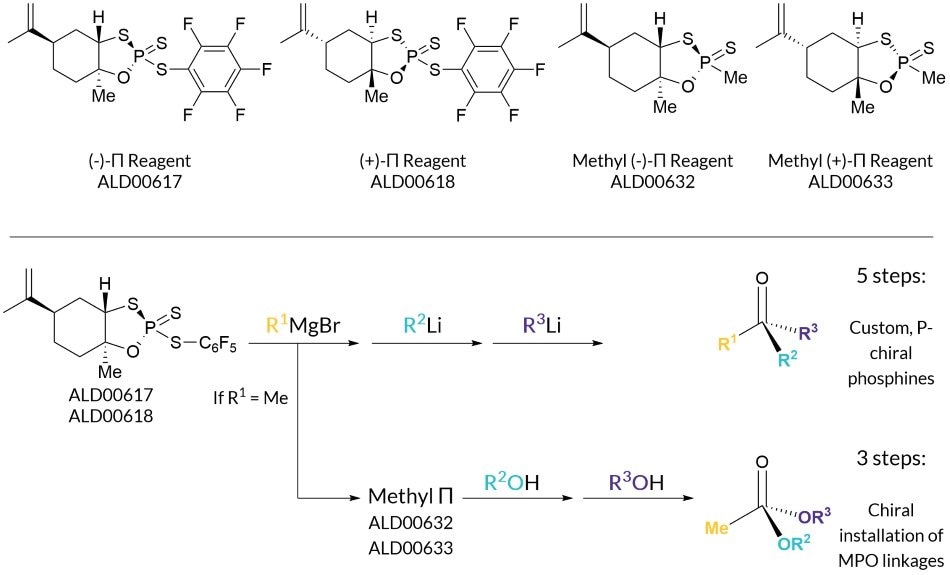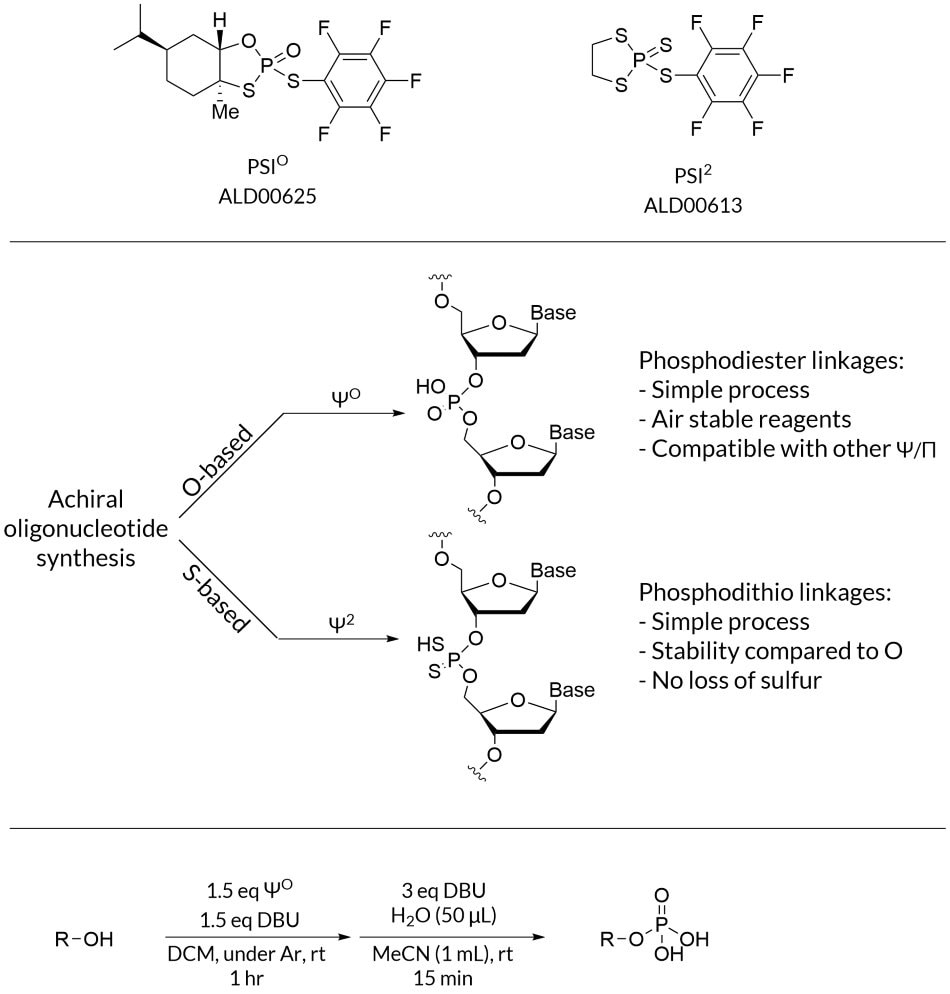PI and PSI – Chiral phosphorus incorporation harnessing the potential of P(V)
To both the synthetic organic chemist and chemical biologist, organophosphorus moieties can be found in many of the most powerful and widely studied compounds. As a synthetic organic tool, phosphorous compounds are used as reagents in many staple organic transformations such as Wittig and Staudinger reactions, and phosphines are widely used as ligands in organometallic cross-coupling catalysts. To a chemical biologist, phosphorous is often nature’s preferred method to solve problems: forming nucleotides, lipid bilayers, and ATP all rely on phosphates and their esters to function.
At the junction of these areas of study, phosphorus chemistry has been integral in the establishment of modern methods of producing synthetic oligonucleotides.1 These methods primarily utilize P(III) based reagents due to their observed high reactivity compared to P(V); however, both they and their primary building blocks are air and moisture sensitive. Most modern methods make use of phosphoramidites, and utilize solid-phase supports and a complex, multi-step process.2,3 Professor Phil Baran and his lab proposed that a P(V) centered approach that offered comparable or improved performance compared to the existing P(III) method would be highly advantageous. In collaboration with researchers at Bristol Myers Squibb, they developed this idea along with the platforms of phosphorous sulfur incorporation (PSI, or Ψ)4 and phosphorus incorporation (PI, or Π)5 reagents.
PSI – Enables access to chiral phosphorothioates
To impart new or improved functionality of oligonucleotide-based therapeutics, chemists often turn to making substitutions to the phosphodiester linkages between nucleotides. Of these, one of the most beneficial and widely studied substitutions has been to replace one of the oxygens with a sulfur to form phosphorothioate linked nucleotides. Notably, the thiolated linkage confers both a greater degree of cellular uptake and improved stability to metabolic degradation. As a result, many anti-sense oligonucleotides (ASOs) incorporate this kind of linkage, including those that have both been approved by and are currently in clinical review by the FDA. Historically, the successful development of ASOs has relied on current P(III)-based strategies, and bears many of the challenges inherent in their approach: high sensitivity to air and moisture, challenging procedure, and importantly, lack of stereoselectivity. Conversely, the method enabled by PSI is simple, involving first direct formation of the P-O bond, and deprotection using 3% DCA in DCM.4 (Figure 1)

Figure 1.Phosphorus sulfur incorporation (PSI, Ψ) and the simplified mechanism for incorporation of phosphorothioate linkages into oligonucleotides.
PI – Expands scope to chiral methylphosphonates, and custom phosphines
Another important modification to phosphodiester linkages is alkylation, to form the methylphosphonate (MPO). These are also of interest to researchers because they impart a great degree of stability to oligonucleotides. Identifying that there were few ways to effectively form these linkages, and none that could do so stereoselectively, the Baran lab developed reagents capable of doing this, called phosphorus incorporation (PI, or Π).5 Moreover, PI reagents allow one to customize the substitution present on the phosphoryl linker, allowing any number of substitutions at the researcher’s discretion. As it is arguably the most valuable due to applications in ASO development, we offer the methylated PI reagents as well. However, the Baran lab also observed that through the PI framework, that any number of complex phosphines could be formed by sequential addition of Grignard and alkyllithium, which is of significant value to synthetic chemists. For this reason, we also provide the unsubstituted PI reagents.

Figure 2.Phosphorus incorporation (PI, Π) reagents and the simplified mechanism to form functionalized, chiral phosphines or methylphosphorylate linkages (MPOs) in oligonucleotides.
PSIO and PSI2 – provides greater diversity of racemic and achiral linkages
While one of the most significant improvements imparted by the PSI platform over existing methods is increased stereoselectivity, offering a comprehensive solution for oligonucleotide synthesis also requires inclusion of racemic and achiral linkages. While often substitutions to the phosphodiester linkages in oligonucleotides provide added benefits, much of oligonucleotide research must continue to include the formation and study of native phosphodiester linkages. Thus an effective reagent compatible with PSI was developed (PSIO) to easily install these linkages. Notably, like the PI reagents detailed above, PSIO is also of interest to the synthetic chemist, as it has also been observed to be active in phosphorylating alcohols in a simple and scalable method.6 Finally, phosphodithio linkages are also of considerable interest to researchers as they impart many of the benefits to stability seen in the monosubstituted linkages detailed above, but without the added complexity of installing a stereocenter in the final product. PSI2 was developed to accomplish this, and while existing P(III)-based methods do exist, their efficacy is limited by stability issues, which are avoided by PSI2.

Figure 3.PSI reagents for the formation of achiral phosphodiester/phosphodithio linkages in oligonucleotides, and the phosphorylation of alcohols.
Products
References
如要继续阅读,请登录或创建帐户。
暂无帐户?